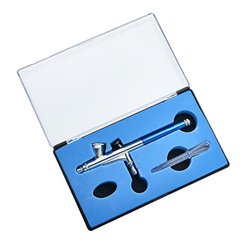You'll likely have come across the term "NEM pockets" when delving into the world of model railway couplers. But what...
No products
Product successfully added to your shopping cart
There are 0 items in your cart. There is 1 item in your cart.
Search Tips
What is the difference between a single action and double action airbrush ?
When it comes to airbrushing, there are two main types of airbrushes : single action and double action. These terms refer to how the airbrush is operated and the level of control the operator has over the paint flow. Let's take a closer look at the differences between single action and double action airbrushes.
- Single action airbrush : a single action airbrush is a basic and straightforward tool. It operates on a simple principle : when the trigger is pressed, both the air and the paint are released simultaneously. The amount of paint that is sprayed is determined by the adjustment of the paint flow knob on the airbrush. This means that the paint flow remains constant unless manually adjusted by the operator.
Single action airbrushes are commonly used for large areas and basic spraying tasks, such as applying a base coat or varnish. They are relatively easy to use, making them a good choice for beginners or those who prefer a simpler airbrushing process. However, they offer less control and precision compared to double action airbrushes.
- Double action airbrush: in contrast, a double action airbrush provides more versatility and control. With a double action airbrush, the operator has the ability to control both the air and the paint flow independently. This means that they can vary the intensity of the paint flow whilst they are spraying by simply adjusting the trigger.
To use a double action airbrush, press down on the trigger to release air, and then pull back on the trigger to control the amount of paint that is released. By varying the pull back distance of the trigger, an operator can achieve different levels of paint flow, allowing for more precise and detailed work.
Double action airbrushes are commonly used for fine detailing, shading and creating intricate patterns. They are preferred by experienced airbrush artists who require a higher level of control and precision in their work.
Click here to receive the tips weekly in your mailbox. You can unsubscribe at any time.









